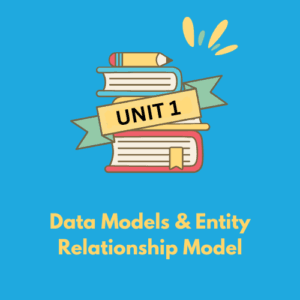
Click On the Download Button Below 
Introduction to Database Models and Entity Relationship Models :-
Entity-Relationship (ER) Model:
- A high-level data model diagram that visually represents real-world problems to help stakeholders and developers understand the system.
Components of an ER Diagram:
- Entities:
- A real-world thing, which could be a person, place, or concept.
- Examples: Teachers, Students, Courses, Buildings, Departments in a School Management System.
- Attributes:
- Characteristics or properties of an entity.
- Examples: Teacher ID, Salary, Age for the entity “Teacher.”
- Relationships:
- Describes how two entities are related.
- Example: A “Teacher” works for a “Department.”
- Relationship Set:
- A collection of relationships of the same type.
- Formally, a mathematical relation on entity sets.
- Example: A relationship set between “Customer” and “Account.”
- Entities:
Key Constraints:
- The values of a primary key must be unique and not null.
Participation Constraints:
- Participation constraints define whether all or only some entities participate in a relationship.
- These can be captured in binary relationships.
Weak Entities:
- An entity that cannot be uniquely identified by its own attributes.
- Requires a foreign key in addition to its attributes to create a primary key.
This bullet-point structure summarizes the ER Model and its components.
Objectives of Database Models and Entity Relationship Models :-
Clear Visualization of Real-World Relationships:
- To visually represent and model real-world objects and their relationships in a way that is easy for both developers and non-technical stakeholders to understand.
- Serves as a bridge between business requirements and the database design.
Facilitate Database Design:
- Helps in designing databases by providing a clear framework for organizing entities and their relationships.
- Supports the creation of efficient and normalized database structures.
Identification of Entities and Relationships:
- Allows for the identification of key entities (objects) and the relationships between them.
- Helps to define how data in one entity relates to data in another, ensuring proper linkages and dependencies.
Foundation for Database Schema:
- Acts as a blueprint for translating the real-world problem into a logical schema that can be implemented in a relational database.
- Serves as the foundation for creating tables, relationships, and constraints.
Improvement of Data Consistency and Integrity:
- By defining relationships and constraints, the ER model ensures that the data remains consistent and adheres to business rules.
- Helps in identifying any redundancies or anomalies in data relationships.
Simplification of Complex Systems:
- Breaks down complex systems into manageable parts by identifying entities and their attributes.
- Simplifies the process of designing systems by making it easier to understand the key components and their interactions.
Enhanced Communication:
- Provides a visual tool to communicate the structure of a database clearly among stakeholders, designers, and developers.
- Facilitates discussions on system requirements and helps in decision-making.
Facilitating Normalization:
- Helps in understanding the relationships between entities, which is crucial for applying normalization techniques.
- Ensures efficient storage and avoids data anomalies by designing databases that minimize redundancy.
Both Database Models and Entity-Relationship Models serve essential roles in ensuring that databases are well-structured, efficient, and scalable, while also ensuring clarity and communication among stakeholders.
Summary of Database Models and Entity Relationship Models :-
Database Models:
- Purpose: Organize, store, manage, and retrieve data efficiently.
- Key Objectives: Ensure data integrity, minimize redundancy, enhance security, support efficient queries, and ensure data independence.
- Features: Reduces errors, provides data security, ensures fast data retrieval, and enables concurrent access.
Entity-Relationship (ER) Models:
- Purpose: Visually represent real-world entities and their relationships.
- Key Objectives: Facilitate database design, identify entities/relationships, and ensure data consistency.
- Features: Provides a clear blueprint for database schema, aids in normalization, and simplifies communication between stakeholders.
Database Systems Subject Link
